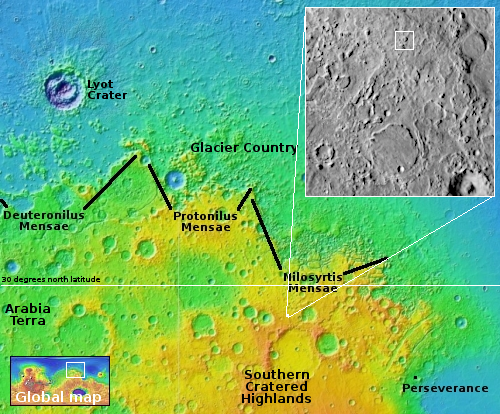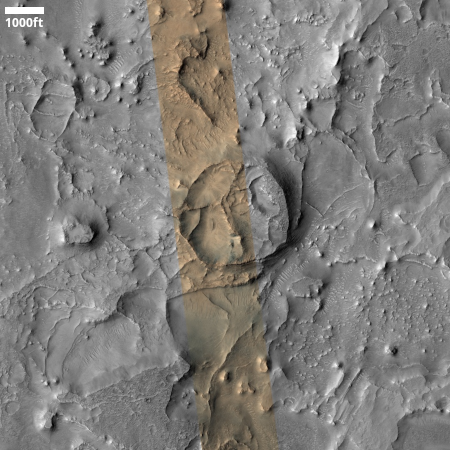Weird “What the heck?!” pedestal crater on Mars
Cool image time! The picture to the right, cropped and reduced to post here, was taken on August 26, 2025 by the high resolution camera on Mars Reconnaissance Orbiter (MRO). While the full image shows what the camera team labels as the “ridges” that cover this area, the most prominent feature in the whole landscape is this half-mile-wide pedestal crater, sitting about 50 to 100 feet above the surrounding terrain.
What makes this strange butte so weird is the plateau on top, criss-crossed with ridges and hollows in a manner that defies any obvious geological explanation.
Pedestal craters are not uncommon on Mars, and in fact a bunch of others are found throughout this region. The theory for their formation is that they formed when the surface here was much higher. The impact made the crater floor more dense and resistant to erosion, so as the surrounding terrain wore aware the crater ended up being a butte.
However, pedestal craters usually have relatively smooth tops, making this crater another example of a “What the heck?” image.

The white dot on the overview map to the right marks the location, inside the dry tropics of Mars and on the southern cratered highlands. As you can see by the inset, there are a number of round mesas that appear to be pedestal craters, except all have very smooth flat tops.
What caused the top of this crater to appear so different? I have no idea at all. I could guess and say we are looking at ancient erosion features left over when there was once ice inside the crater, but that guess really doesn’t work because the ridges and hollows on the top of this pedestal look nothing like the glacier features found inside craters at higher latitudes, where near surface ice is present.
As I have said numerous times before, Mars is an alien world. Do not assume anything about its geology, based on what we know here on Earth.
On Christmas Eve 1968 three Americans became the first humans to visit another world. What they did to celebrate was unexpected and profound, and will be remembered throughout all human history. Genesis: the Story of Apollo 8, Robert Zimmerman's classic history of humanity's first journey to another world, tells that story, and it is now available as both an ebook and an audiobook, both with a foreword by Valerie Anders and a new introduction by Robert Zimmerman.
The print edition can be purchased at Amazon or from any other book seller. If you want an autographed copy the price is $60 for the hardback and $45 for the paperback, plus $8 shipping for each. Go here for purchasing details. The ebook is available everywhere for $5.99 (before discount) at amazon, or direct from my ebook publisher, ebookit. If you buy it from ebookit you don't support the big tech companies and the author gets a bigger cut much sooner.
The audiobook is also available at all these vendors, and is also free with a 30-day trial membership to Audible.
"Not simply about one mission, [Genesis] is also the history of America's quest for the moon... Zimmerman has done a masterful job of tying disparate events together into a solid account of one of America's greatest human triumphs."--San Antonio Express-News
Cool image time! The picture to the right, cropped and reduced to post here, was taken on August 26, 2025 by the high resolution camera on Mars Reconnaissance Orbiter (MRO). While the full image shows what the camera team labels as the “ridges” that cover this area, the most prominent feature in the whole landscape is this half-mile-wide pedestal crater, sitting about 50 to 100 feet above the surrounding terrain.
What makes this strange butte so weird is the plateau on top, criss-crossed with ridges and hollows in a manner that defies any obvious geological explanation.
Pedestal craters are not uncommon on Mars, and in fact a bunch of others are found throughout this region. The theory for their formation is that they formed when the surface here was much higher. The impact made the crater floor more dense and resistant to erosion, so as the surrounding terrain wore aware the crater ended up being a butte.
However, pedestal craters usually have relatively smooth tops, making this crater another example of a “What the heck?” image.

The white dot on the overview map to the right marks the location, inside the dry tropics of Mars and on the southern cratered highlands. As you can see by the inset, there are a number of round mesas that appear to be pedestal craters, except all have very smooth flat tops.
What caused the top of this crater to appear so different? I have no idea at all. I could guess and say we are looking at ancient erosion features left over when there was once ice inside the crater, but that guess really doesn’t work because the ridges and hollows on the top of this pedestal look nothing like the glacier features found inside craters at higher latitudes, where near surface ice is present.
As I have said numerous times before, Mars is an alien world. Do not assume anything about its geology, based on what we know here on Earth.
On Christmas Eve 1968 three Americans became the first humans to visit another world. What they did to celebrate was unexpected and profound, and will be remembered throughout all human history. Genesis: the Story of Apollo 8, Robert Zimmerman's classic history of humanity's first journey to another world, tells that story, and it is now available as both an ebook and an audiobook, both with a foreword by Valerie Anders and a new introduction by Robert Zimmerman.
The print edition can be purchased at Amazon or from any other book seller. If you want an autographed copy the price is $60 for the hardback and $45 for the paperback, plus $8 shipping for each. Go here for purchasing details. The ebook is available everywhere for $5.99 (before discount) at amazon, or direct from my ebook publisher, ebookit. If you buy it from ebookit you don't support the big tech companies and the author gets a bigger cut much sooner.
The audiobook is also available at all these vendors, and is also free with a 30-day trial membership to Audible.
"Not simply about one mission, [Genesis] is also the history of America's quest for the moon... Zimmerman has done a masterful job of tying disparate events together into a solid account of one of America's greatest human triumphs."--San Antonio Express-News


